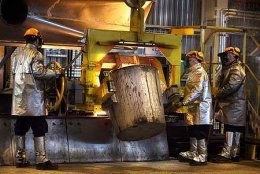Lori Pottinger
Huffington Post
21 December 2010
Please, ma’am, just put down the aluminum foil and no one gets hurt.
It’s a little known fact that this simple kitchen product has a Dickensian dark side. So as you serve your guests canned beverages, “tent” your turkey, cover the yams, or wrap leftovers at the end of the party, keep in mind that the aluminum products you’re using have their roots in a dirty industry — one that frankly deserves a lump of coal in its stocking for how it’s mistreating the planet.
The aluminum industry is the world’s largest industrial consumer of electricity, and about half of what it uses comes from hydropower dams. Aluminum companies troll the world looking for big dam projects that can power new smelters, often targeting rivers in ecologically sensitive areas in developing countries, and frequently in places where basic needs for the population’s energy are not being met.
The industry is also a first-class cheapskate in the mold of Dickens’ Scrooge, often paying less for its electricity than everyone else. Major aluminum companies are notorious for landing sweetheart deals for energy at below-cost prices, along with commitments of vastly out-of-proportion amounts of electricity in places where per-capita energy use is extremely low, blackouts are frequent, and most people live without benefit of modern energy services.
And that doesn’t include the extraction of bauxite to make the stuff, which leaves behind polluted and denuded land, poisonous water, dirty air and other environmental insults.
Like I said, Santa, a lump of coal for Big Aluminum, please.
The big aluminum companies of the world have been behind some very dirty dams, including one that flooded 4% of Ghana and spread disease to those living nearby; one in Brazil that flooded out 24,000 Amazon Indians and a species-rich forest the size of Sicily; and another in Iceland‘s once-pristine glacial north that creates more energy than is used by the entire population of Iceland — all of it used to power just one Alcoa smelter, whose promises of jobs and economic growth for the struggling region haven’t panned out.
Big aluminum is behind devastating new dams planned for the Amazon, the Zambezi, the Congo, and rivers in Chilean Patagonia, Cameroon, Angola and more.
One particularly egregious example of big aluminum at work is in the Democratic Republic of Congo, a poor and corrupt nation just coming off years of war. The Congo River has Africa’s highest potential for hydropower, and BHP Billiton — the world’s largest aluminum company — has plans to develop it. In a country where 94% of the population has no access to electricity, one would think the government would find higher and better uses of its energy resources than making soda cans.
“One of the world’s richest corporations is jumping the development queue ahead of some of the world’s poorest people. BHP Billiton’s flagrant disregard for the consequences of this venture is alarming,” says my colleague Terri Hathaway. She and colleagues from around the world are trying to convince BHP Billiton to keep their hands off the Congo River.
Every one of us can pitch in on this issue. Consider becoming an “aluminum Scrooge” by using as little aluminum as you can, while recycling or re-using what you must use (and enlisting your peeps to do the same). Find a lid for that yam pan! Give the leftovers to friends in re-usable containers! This is doable, people.
Recycling really changes the sustainability equation for aluminum. Despite its high recycling potential, however, just half of aluminum cans are recycled. Each one that is thrown away is like throwing away a full can of gasoline in wasted energy. And it’s not just about putting the cans in the bin; it’s about using less, and re-using what you can. It’s also possible to buy aluminum foil made of recycled metal. And, of course, to drink fewer sodas in cans.
Think of it as a gift to the world’s rivers.
Follow Lori Pottinger on Twitter: www.twitter.com/IntlRivers
